Duncan Sidewalk Fixed, Crosswalk at Newstead Still A Problem
Today when I visit Solae it won’t be a challenge like it has been, last month I discovered a problem that existed since the building opened in 2008 has finally been fixed. Last July I posted about the problem and contacted Solae, Cortex and Washington University.
Here’s what it used to look like, the gap was nearly impossible to navigate:
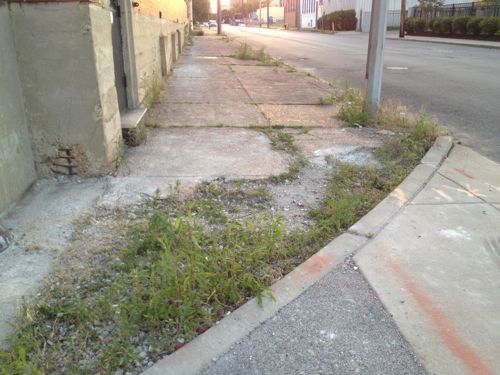
It was suggested in the comments on my post last year that the adjacent building (shown above) owner was responsible. I rejected that idea because it was the construction work at Solae that created the gap that caused the problem. The architect and/or contractor didn’t consider patching the area where they had to over dig.
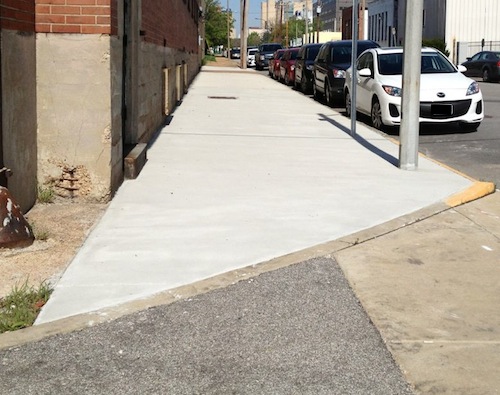
Unfortunately, my trip from the Central West End MetroBus Transfer Center/MetroLink Station still has a major access problem. At Duncan & S. Newstead (map) I can’t use the crosswalk to cross Newstead.
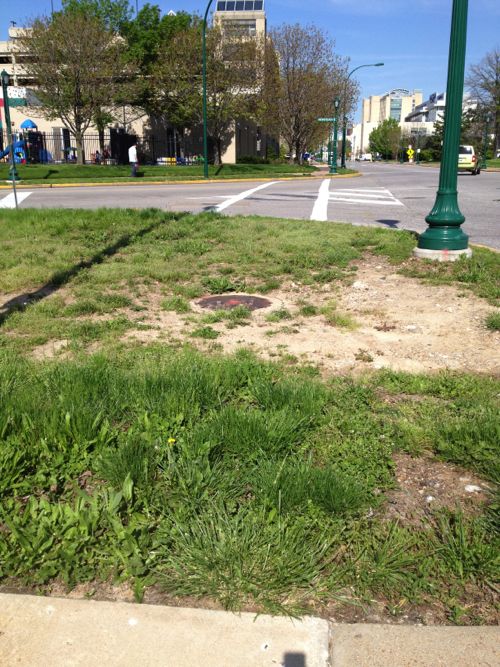
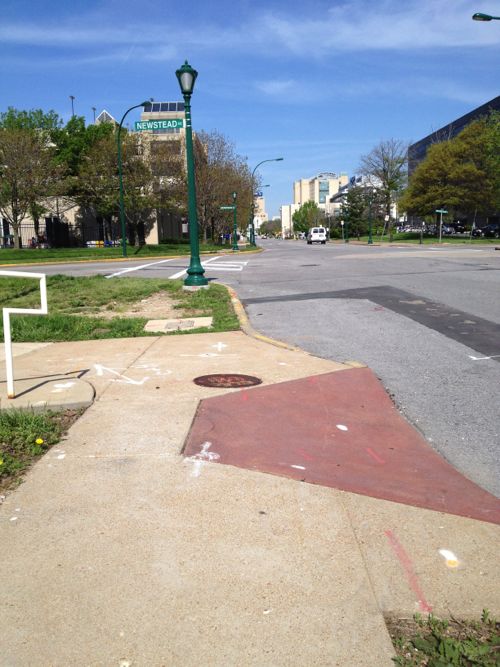
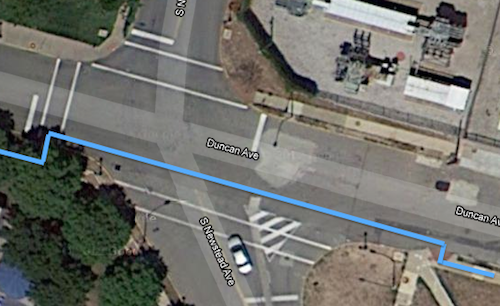
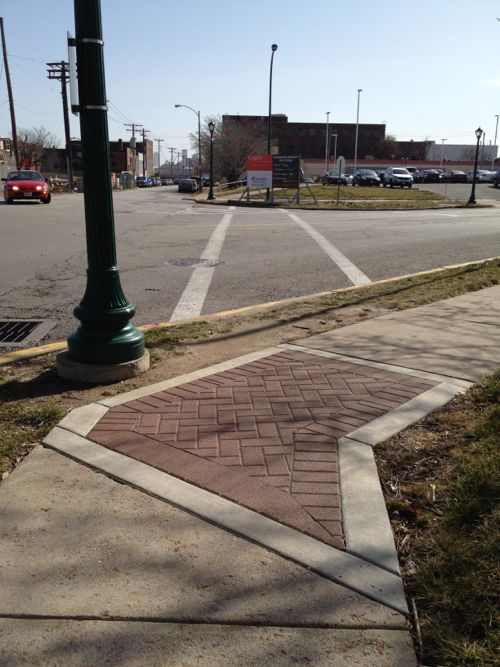
Washington University spent considerable time and money on these decorative inserts, seemingly without thought to the functionality of the pedestrian network. This infuriates me beyond words. The money spent could’ve been used to make the area accessible and the sidewalks wide enough so when you meet someone they don’t have to step off the sidewalk into the grass. These decorative inserts are the type of pedestrian improvements are designed to look good on paper and driving by.
Can you imagine if roads were designed for aesthetics rather than function?
We’ll see how long it takes before I can use the crosswalk.
— Steve Patterson
Agree, functionality should be the number one priority. If you have the money to make decorative enhancements, you have the money to fix functional problems. Bigger picture, does the city have a plan to a) survey, identify and catalog problem areas, b) prioritize which ones should come first, c) establish a realistic schedule and stick to it, and d) FUND IT!? The ADA requires this, and it can and should be (have been?) accomplished in the years since the ADA became law: http://www.ada.gov/pcatoolkit/chap6toolkit.htm . . . . http://www.denvergov.org/disabilities/CurbRampProcess/tabid/432256/Default.aspx
The problem is that this isn’t sexy work. Politicians aren’t lining up to get their pictures taken at the newest curb ramp and many property owners either don’t have the funds or don’t see it as a priority to spend money on adding ramps to existing corners. This is something that government can do well – solicit bids to install x number of ramps, sign the contract and git ‘er done: http://walksteps.org/case-studies/denver-pedestrian-master-plan/ – but it takes making the commitment. Bottom line, it’s all about priorities, and in the Lou, it seems like brick gateways and artistically-painted fire hydrants are a bigger priority (for some aldermen) than spending money on curb ramps . . . .
If only STL had more people like you reporting these issues, the sidewalks wouldn’t be in the miserable state of disrepair they’re in throughout most of the city.
STL should make it easier to report these issues. Madison (WI) has a “Report a Problem” website (https://www.cityofmadison.com/reportaproblem/sidewalk.cfm) where you can report sidewalk issues. The sidewalks in Madison are the best I’ve ever seen. Cracked blocks are replaced within a month and if a block tilts up for whatever reason (tree root, whatever), they grind it off so that it’s smooth again.
Not to be cynical, but there’s a difference between reporting a problem and seeing the problem fixed. The problem in the city is a combination of limited resources and different (misplaced?) priorities. Is it more important to fight crime, fight fires or fix sidewalks?
Very true. Of course there are the “broken window” theory people who’d say that by fixing things like sidewalks you’d actually deter crime.
1) I see sidewalk repair work being done all over the City. Sorry if these intersections aren’t the ones you need at the time. Why not let the Streets Department know a few weeks ahead of time where you will be going and I’m sure they (well, their sub-contractors) will stop all the work on the others just to prioritize yours.
2) Hell must have frozen over. A criticism of Washington University.
Yes, very silly of me to think an intersection less than a 1/4 of a mile from the busiest light rail station be accessible 20 years later.
Man Steve, you take heat in the most ridiculous ways (Moe). Keep on truckin. Scott, Madison’s system sounds great. Here you have to pick up the phone, and I have many times–for sidewalks, trees, water issues, business licenses. I’ve found city workers to be courteous, responsive and in every case I see action or get an answer in a reasonable timeframe. Really. Are you all still standing? I live in Tower Grove “Heights.” Does that have something to do with the quick response? It sucks but I’ll bet it does. (Yes I’m askin about racism).
Tweet a pic, specific location & description to Citizens Service Bureau https://twitter.com/stlcsb
It would be one thing if this were an untouched intersection but clearly both sides of Newstead have seen extensive work done to the sidewalk. For nearly the same expenditure Wash-U/CORTEX could have improved accessibility but chose against it. Such action is a slap in the face of ADA is it not?
Those who criticize ADA compliance seem to forget that it isn’t only those in a chair who benefit. Seniors, people with injuries that effect motor control, the blind, etc… The intersection in question here actually forces someone like Steve to cross the street IN TRAFFIC. Clearly these plans were approved by a buffoon.
Agreed. Taken one step further, ADA compliant ramps and sidewalks benefit EVERYONE. The law calls for pedestrians to cross at a crosswalk, plain and simple. If the lawmakers/enforcers don’t provide an accessible and straightforward way to do so, they are undermining their own ability to govern.
Similarly, a strong system of crosswalks DOES get noticed by drivers and, in turn, encourages then to respect the law and the protections/rules for pedestrians. And might even result in a few new pedestrians too.
Simple decisions and efforts are the things that help good cities become great ones.